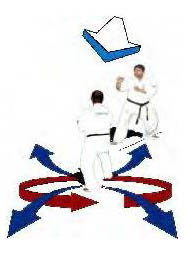What is Sabaki?

- Sabaki is a unique method of meeting an attack by combining defence and offence into one.
- Sabaki uses one of four fundamental circular movements in response to an attacker’s thrust. These movements carry the defender to the outside- left or right of an attack, moving either slightly forward or backward.
- In each case, the defender move’s to the attacker’s back side. This limits the defender’s exposure to frontal attack. In addition, it allows the defender to develop a “blind spot” in the attacker’s position.
- Once the defender has developed this “blind spot”, he/she can take strategic advantage of this position by entering that “blind spot” and countering effectively with various combinations of punches and kicks.
- No matter what the distance – short, medium or long – this strategy of moving outside and to an opponent’s “blind spot” is essential.
- In Ashihara Karate the practitioner learns to be aware of three types of distances and the Sabaki that applies to each.

What does Sabaki mean?
Sabaki is a difficult concept to translate from Japanese. Broadly speaking, Sabaki refers to movement, often involving a concept of control, sometimes implying preparation for a subsequent movement. For example, Sabaki can be used in reference to training a horse. The rider performs certain movements in an effort to control the animal, in order to make the animal behave as he/she wants it to.
Kancho Hideyuki Ashihara has adopted the word Sabaki to epitomise the essence of this style of Karate. In Ashihara Karate, Sabaki describes the movement made by a defender stepping out of line of an attack, into a position from which he/she can launch a counterattack. This controlled movement, in preparation for a subsequent advance, is the basis of the strategy of Ashihara Karate: the combination of defence and offence into one … SABAKI.


 D5 Creation
D5 Creation